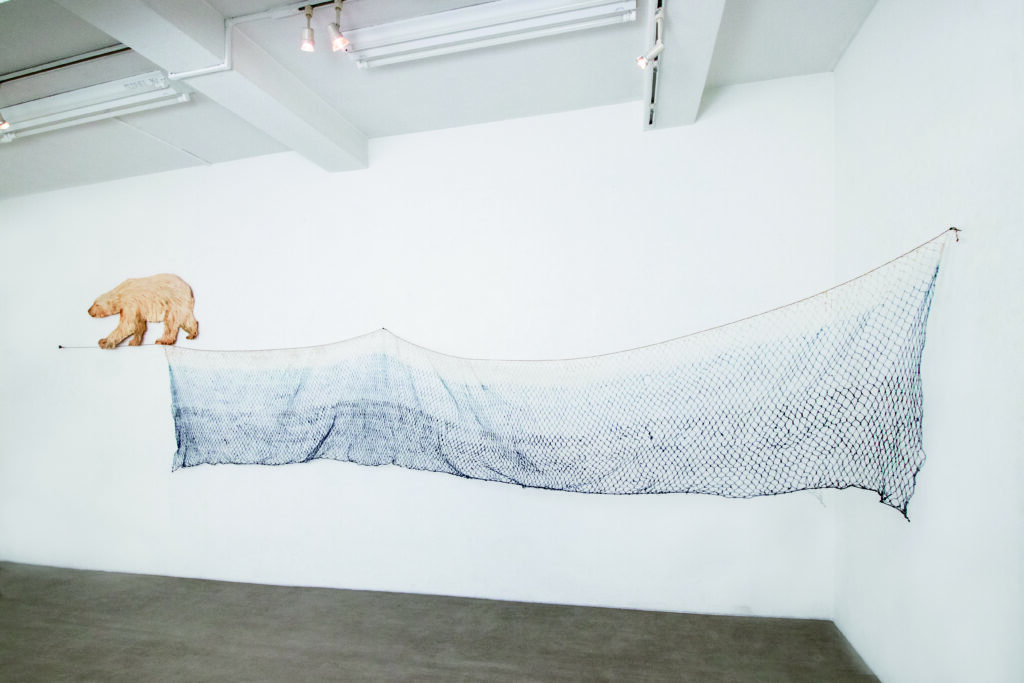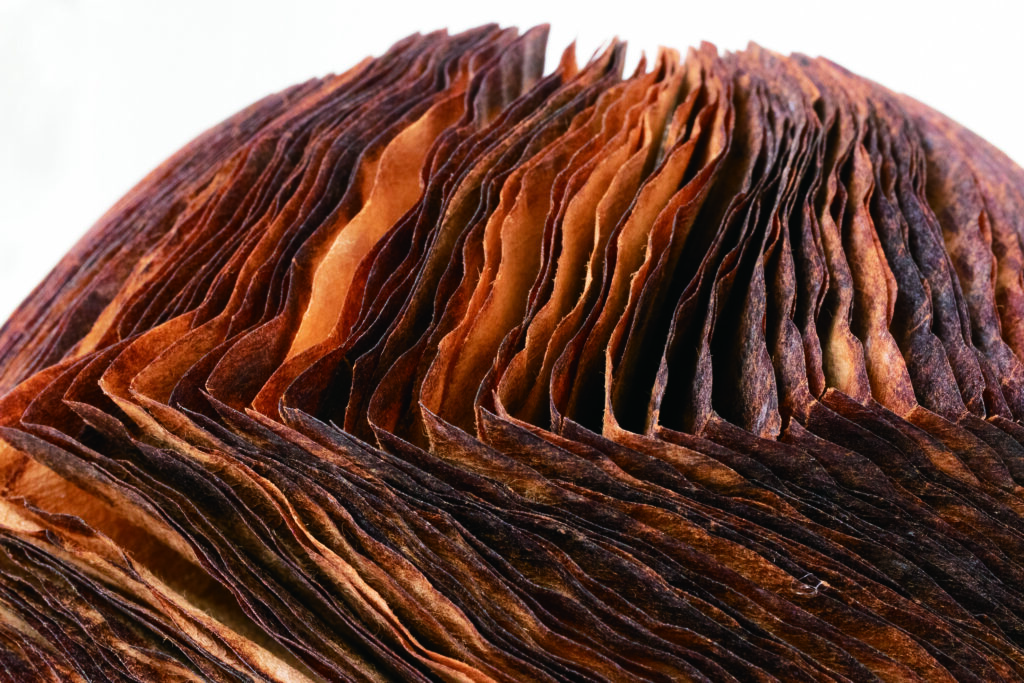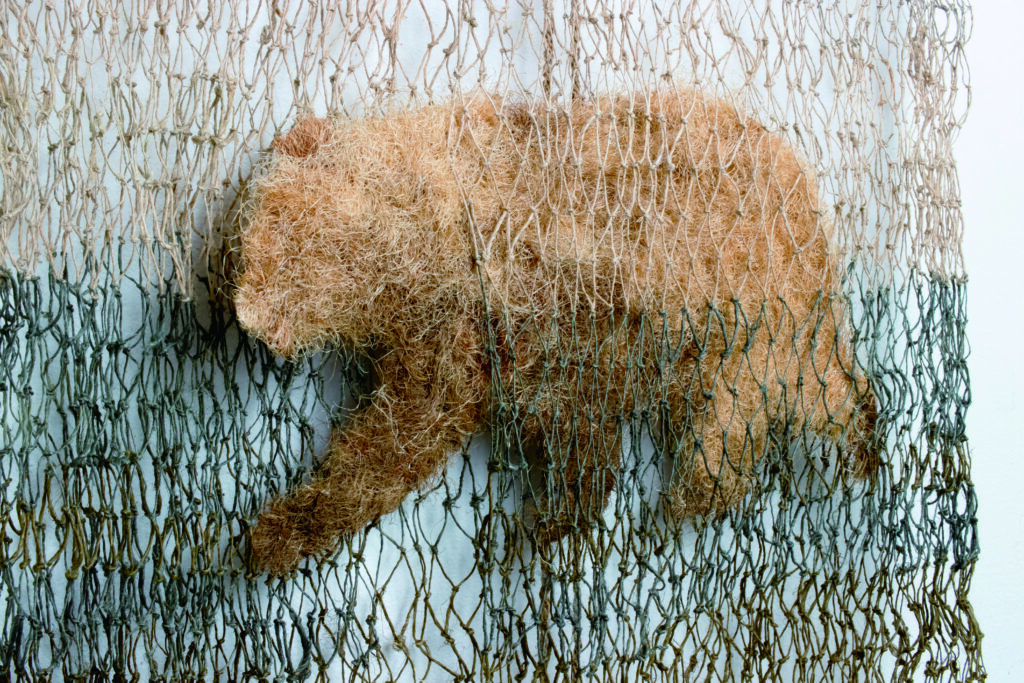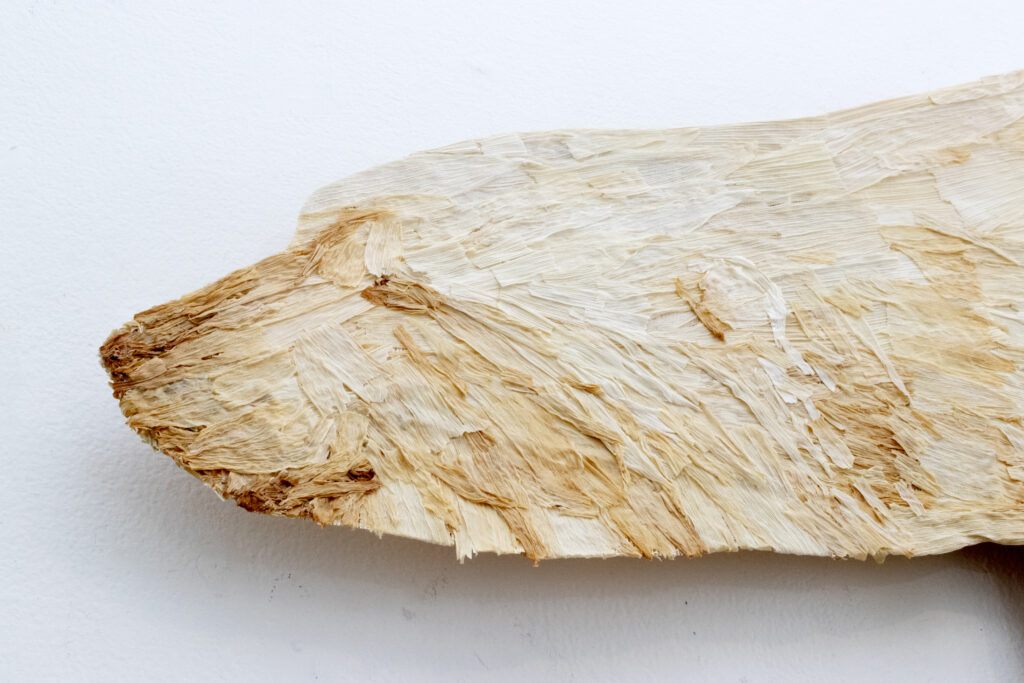
「テキスタイルは体育会系よ」
と鈴木純子は言う。織り機に向かって作業を続けるのは体力を必要とするということなのだろう。一日中織り続けていると、腕と肩がぱんぱんに張ってしまうそうだ。
「鶴の恩返し」の鶴のように、三日三晩自分の羽を抜いて布を織っていき、次第にやつれていく姿を織りの作家と重ね合わせていたのだが、実際はムキムキの筋肉マンなのかもしれない。
鈴木は武蔵野美術大学の学生だったころから、現在につながる仕事を始めている。
布にシルクスクリーンで写真を印刷する。人物や風景などのさまざまなイメージが凹凸のある画面に定着していく。そのままだと「ぺたっと」してしまうので、緯糸(ヨコイト)だけ全て解いて、織り直す。言葉にすると単純でなんでもない仕事のように思えるのだが、実際は気の遠くなるような細かい作業が待ち構えている。解いた糸は、解いた順番に保管する。順番を間違えると、写真のイメージが壊れてしまうからだ。解いた糸を解いた順番に一本ずつ織り込んでいく。間違いは許されない。同じ順番に織っていけば、もとの写真の画像と同じものが再現されていくはずなのだが、実際はもとの画像とはかなり雰囲気の違ったものが出来上がる。同じように織り直しても、少しずつズレが出てくるし、布の密度も変わってくるので、それが微妙な風合いを醸し出すのだ。
この織り直しは「ほぐし絣」という伝統技法をベースに鈴木のオリジナルにしたそうである。
解されて織り直された画面は、テキスタイルのタペストリーというよりは、一枚の絵画作品になっていて、わたしたちの眼前に重層化された空間を展開する。
記録として撮影された写真は、布に印刷され、解され織り込まれることで、わたしたちの思い出を刺激する記憶として現われてくる。
鈴木は、自分の作品を工芸と呼ばれたくない、と言う。自分の作品は染色、織り、ファイバー・アート、デザインなどのジャンルには属していないということの毅然とした表明である。では、鈴木純子の作品を、わたしたちは何と呼べばいいのだろうか。
話は少し逸れる。
2020年、新型コロナとい名前のウィールスが世界中に蔓延し、大パニックをあらゆる国に引き起こして、それは現在も続いているのだが、ウィールス対応と同時に、いったいウィールスって何?という話題もあちこちで取り上げられた。ウィールスは生物なのか、それとも無生物なのかという議論である。どちらのカテゴリーに入れるべきかという問題なわけなのだが、そのどちらでもないというのが正しいようである。どちらでもないというよりは、新しい名前を与えるべきなのかもしれない。生物の中でも、植物と動物という分け方をしているが、実際はどちらでもない、あるいはどちらとも呼べるような中間的な生物が存在することで、この分け方も破綻している。
美術の世界でも同様に、伝統的な分類の仕方では捉えきれないジャンルが出てきている。絵画、彫刻、デザイン、工芸、版画、写真、映像などの分け方では対応できない作品群が現われてきているのだ。従来の分類法の中に無理やり押し込めてしまうと収まりがつかなくなってしまうが、かといって、カテゴリーを増やしすぎても何がなんだかわからなくなってもしまう。分類なんていうものは意味がないので、撤廃したらいいという意見もあるだろうが、分類するというのは、大変便利でもあって、物ごとを理解しやすくしてくれる。しかも人間は分類することが大好きなのである。
古い分類法から離れていく鈴木純子作品は、その後、さらにその「過激さ」を増していく。
2000年に制作した「NEWTHREAD?」は、新聞紙で作った立体作品である。「ニュース」を「糸」にするという試みである。カラフルな海外の新聞紙で紙縒(コヨリ)を作っていくという時間のかかる作業である。紙縒作りは集中力が要る手作業だが、鈴木は、我儘で食いしん坊の魚 「Selfish」や、「Jackson Chameleon」などのユニークなものを次々に生み出していった。
2021年の個展では、これはテキスタイルと呼んでいいのか?という実験的な作品を展示した(2021年 2月8日(月)-13日(土) Steps Galley/東京)。
「なめとこやまの熊」というタイトルの作品では、熊をとうもろこしの髭で作り、大麻の繊維を編んで作った網にからませて、鈴をつけたものである。「Polar bear」は白熊をとうもろこしの皮で造型した。この作品を作るために、鈴木は「とうもろこしをいっぱい食べた」そうである。こちらの熊には、大麻を編んで藍で染め海をイメージした網を壁に這わせて、その上を歩かせるという体裁をとった。
コーヒーのペーパーフィルターを使った 「break time」 は、自分で飲んだコーヒーに使用したフィルターを集めて立体に仕上げた作品だ。紙をコーヒーで染めたものということもできる。それにしてもずいぶんの数だが、何年もかけて集めたものなのであろう、作品からコーヒーの香りはすっかり消えていた。
彼女によると、世界で農薬を使用している農作物のなかで、コーヒーは2番目に多いそうである。
今回使用している大麻はもちろん麻薬の原料になるわけだが、こちらは栽培するときに農薬がいらないそうである。皮肉なものである。
今回の個展作品は、熊や抽象的立体といった、造形的な魅力もさることながら、とうもろこしや大麻、コーヒーといった素材そのもののもつメッセージ性が強調されていて、わたしたちに強く訴えかけてくる。
個展会期中に、どんぐりで染めた糸をもってきて見せてくれたのだが、鈴木の「素材好き」がひしひしと伝わってくるのだった。
これからの作品が、どのような展開を見せてくれるのか楽しみであるが、さて、鈴木純子の作品を何と名付けて分類したらいいのか悩ましいところでもある。
2021年 2月
(よしおか まさみ/美術家・Steps Gallery 代表)



Messages of the Materials―Junko Suzuki’ Textiles
“Creating textiles is akin to playing sports”
so says Junko Suzuki. What is meant is that working continuously on a loom is physically demanding and her arms and shoulders get very stiff after weaving all day long.
I had somehow overlapped the image of the crane in the “Grateful Crane” getting thinner and thinner from weaving with her feathers continuously for three days and three nights but in reality the image should perhaps have been of a muscular man.
Suzuki started working on a job that would lead to her present career when she was still a student at Musashino Art University.
Printing photographs on cloths with silk screens and affixing the various images of people and scenery onto uneven surfaces. If left as it is, it will look ‘flat’ so it is rewoven after unraveling all and only the weft threads. It sounds simple and easy but in reality it is a daunting intricate task. The unraveled threads are stored in the order in which they were unraveled. It is because if the order is wrong, the image of the photo becomes flawed. The unraveled threads must be re-woven one by one in the right order. There is no room for error. If you weave them in the same order, you should be able to reproduce the original image of the photo but in reality, you end up with something with quite a different atmosphere from the original image. Even if it is re-woven in the same way, there will be slight deviations and the density of the cloth will be different as well, and that gives it its subtle texture.
This re-weaving is Suzuki’s original method based on the traditional technique of “Hogushi Kasuri’.”
The unraveled and re-woven surface looks more like a painting rather than a textile tapestry producing a multi-layered realm before our eyes.
Photographs taken for record are printed on cloth, and through unraveling and re-weaving, appear as memories that stimulate our recollections.
Suzuki says she does not want her work to be called ‘craft.’ It is a resolute statement to say that her work does not belong to the genres of dyeing, weaving, fiber art or design. Then what are we supposed to call Junko Suzuki’s work?
I will digress a little.
In 2020, a virus called Covid-19 spread throughout the world causing great panic in various countries. It is still ongoing but together with the topic of pandemic response, there was a lot of talk about what a virus really is. The debate is whether a virus is a living or non-living organism. It is a question of which category they should be placed in, but it may well be correct to say that they belong to neither. But rather than saying so, perhaps we should call it something different. Organisms are divided into plants and animals but this division is already bankrupt by the existence of intermediate organisms which in fact can be both or neither.
Similarly, in the art world, genres are emerging that cannot be divided by traditional classifications. Groups of works that cannot be classified as painting, sculpture, design, craft, printmaking, photography or film are popping up. If you try to force them into the traditional classification, it will create a disarray, but on the other hand, adding too many categories will only make it more confusing. Some would argue that classification is meaningless and should be abolished, but classifications are very useful and makes things easier to understand. And moreover, humans like to classify things.
Junko Suzuki’s work which is moving away from the old classifications has since become even more radical.
“NEWTHREAD?” created in 2000 is a three-dimensional work made from newspapers. It is an attempt to turn ‘news’ into ‘threads.’ This is a time-consuming process of making koyori (paper twines) from colorful foreign newspapers. Making koyori is a manual process that requires a lot of concentration, yet Suzuki has come up with a number of unique creations, such as the selfish and gourmand fish, “Selfish” and “Jackson Chameleon.”
In her 2021 exhibition, (Feb. 8 (Mon) – Feb. 13 (Sat) Steps Gallery, Tokyo) she displayed experimental works that made you wonder whether they could be called textiles.
In the work titled “The Bears of Mt. Nametoko,” the bear is made from corn beard which is entwined into a net woven from hemp fiber with a bell attached to it. “Polar bear” is shaped from corn husks. Suzuki says she ate a lot of corn while working on this project. For this bear, she chose a format of hanging along a wall a net woven from hemp and dyed with indigo in the image of the sea and made it to look as if the bear is walking over it.
“break time” is a three-dimensional work created from accumulated coffee filters she had actually used to make her own coffee. You could also say that they are paper dyed with coffee. Nonetheless it must have taken years to collect so many and the scent of coffee has completely disappeared.
According to Suzuki, coffee ranks second in the world as a crop that uses the most agrochemicals.
Hemp used in the current work, needless to say is a raw material for narcotics so pesticides are not required during cultivation which is ironic.
The current exhibition works are not only attractive in a figurative sense with the bears and abstract dimensional shapes but they also emphasize messages of the materials such as corn, hemp and coffee, which appeals to us strongly.
During the exhibition, she showed us threads that were dyed with acorns and we could feel Suzuki’s ‘passion for her materials.’
It will be interesting to see how her work develops in the future, but it will also be hard to put a label and classify these magnificent works by Junko Suzuki.
February 2021
(Masami Yoshioka/Artist & Steps Gallery Representative)
